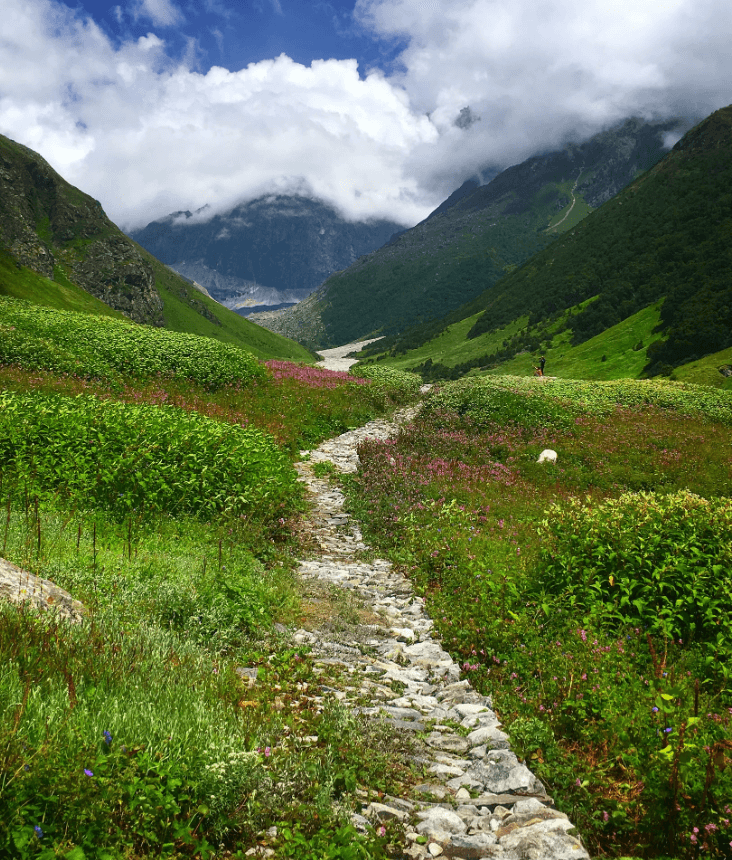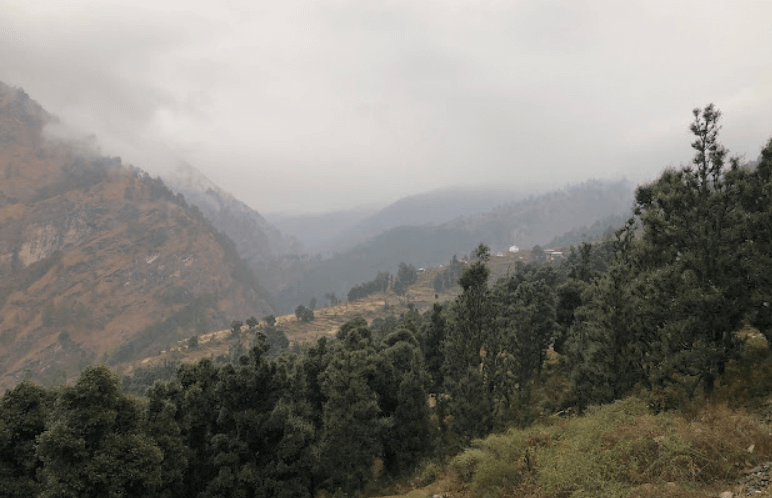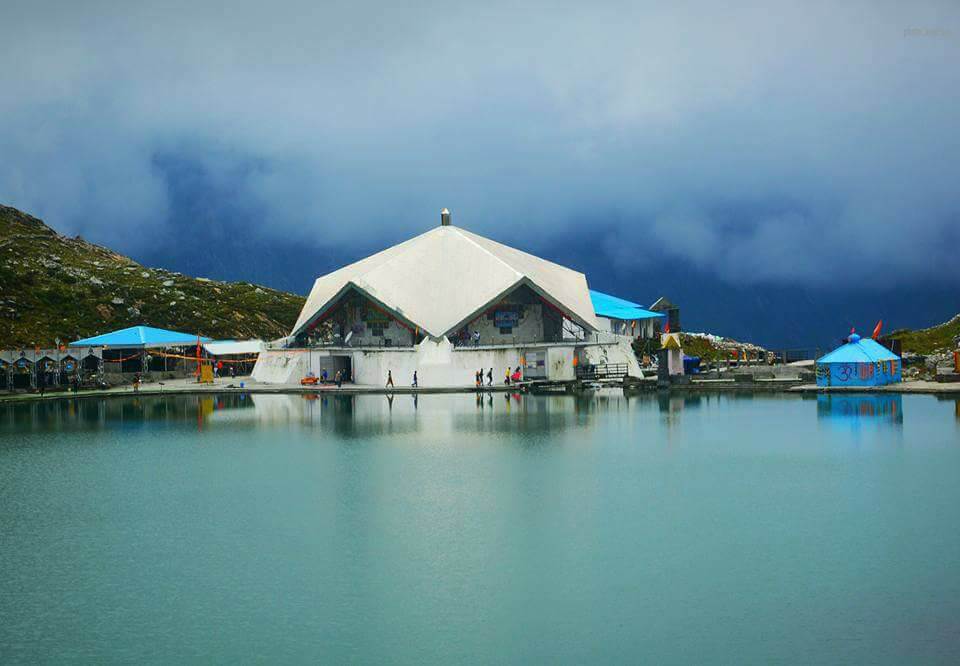The Valley of Flowers National Park is a UNESCO World Heritage Site located in the Indian state of Uttarakhand. It is renowned for its breathtaking natural beauty, rich biodiversity, and vibrant floral display.

Valley of Flowers – UNESCO World Heritage Site
The Valley of Flowers trek is a breathtaking journey through the West Himalayan region of Uttarakhand, where nature’s beauty is showcased in its purest form. As you traverse dense forests, follow the meandering path alongside the Pushpawati river, and cross bridges spanning over cascading waterfalls and glaciers, you’ll find yourself immersed in a truly magical experience.
This pristine valley, designated as an Indian National Park and a UNESCO World Heritage Site, is a sanctuary for rare and exotic Himalayan flora. It’s like walking through a floral paradise, with plush meadows adorned by a vibrant tapestry of endemic alpine flowers. The diversity of fauna adds another layer of enchantment to this already captivating landscape.
The Valley of Flowers trek offers not just physical adventure but also a spiritual journey as you find yourself surrounded by the serene beauty of nature.
Some Key Points about The Valley Of Flowers National Park
Location: It is situated in the western Himalayas, in the Garhwal region of Uttarakhand, India. The nearest town to the park is Joshimath.
Establishment: The park was established in 1982 and was later declared a UNESCO World Heritage Site in 2005.
Flora: The valley is famous for its diverse alpine flowers, which bloom in a riot of colors during the monsoon season (July to September). The park is home to numerous species of flowers, including orchids, poppies, primulas, marigold, daisies, and anemones, among others.
Fauna: The Valley of Flowers is also inhabited by various species of animals, including the elusive snow leopard, musk deer, red fox, and Himalayan black bear. Birdwatchers can spot several bird species such as the Himalayan monal pheasant and the red-billed blue magpie.
Best Time to Visit: The best time to visit the Valley of Flowers is during the monsoon season, from July to September, when the flowers are in full bloom.
Conservation: The park is protected under Indian wildlife protection laws and efforts are made to preserve its fragile ecosystem and biodiversity.
Overall, the Valley of Flowers National Park is a paradise for nature lovers, trekkers, and photographers, offering a unique opportunity to experience the splendor of the Himalayan flora and fauna.
Activities in Valley of Flowers National Park
Trekking: Trekking is the primary activity in the Valley of Flowers. The park offers various trekking routes of different difficulty levels, allowing visitors to explore its picturesque landscapes, lush meadows, and vibrant flower fields.
Flower Watching: The park is famous for its rich floral diversity, with numerous species of flowers blooming during the monsoon season (July to September). Visitors can enjoy the sight of rare and endemic flowers like the Brahma Kamal, Blue Poppy, and Cobra Lily.
Photography: The park offers breathtaking vistas and opportunities for photography enthusiasts to capture the stunning landscapes, colorful flowers, and diverse wildlife.
Exploring nearby attractions: Nearby attractions such as Hemkund Sahib, a Sikh pilgrimage site, and the rugged beauty of the Nanda Devi National Park add to the charm of visiting the Valley of Flowers.
Nature Walks: Enjoy leisurely strolls through the valley, taking in the sights, sounds, and scents of the pristine natural surroundings.
History of Valley of Flowers
The Valley of Flowers was discovered by British mountaineers Frank S. Smythe and R.L. Holdsworth in 1931 during an expedition to Mount Kamet.After its discovery, the valley gained popularity due to its exceptional beauty and unique biodiversity.
In 1939, Joan Margaret Legge, a botanist and sister of the eminent British naturalist Frank Kingdon-Ward, lost her life in the valley while studying its flora. A memorial is dedicated to her in the valley.
The area was declared a national park in 1982 by the Government of India.In 2005, it was designated as a UNESCO World Heritage Site due to its outstanding universal value and unique ecological significance.
Mythology About Valley of Flowers
According to local folklore, the Valley of Flowers is associated with the Hindu epic, the Ramayana. It is believed that the valley was the place where Lord Hanuman, the monkey god, found the mythical herb Sanjeevani to revive Lord Lakshmana, who was injured in battle.
The valley is also considered sacred by the locals and is named Bhyundar Valley after the local deity Bhyundar.
Near Place to Visit
How To Reach Sankri
Sankri is a picturesque village located in the Uttarkashi district of the Indian state of Uttarakhand. It serves as a…
Hemkund Sahib
It is also known as Gurudwara Sri Hemkund Sahib Ji, is a Sikh place of worship located in the Chamoli…
How To Reach Valley of Flowers
By Road
Govindghat serves as the starting point for the trek to the Valley of Flowers. It is well connected by road to major cities like Rishikesh, Haridwar, and Dehradun. You can either drive yourself or take a bus from these cities to reach Govindghat. From Govindghat, it’s an approximately 13-kilometer trek to reach Ghangaria, the base camp for the Valley of Flowers trek.
By Train
The nearest railway station to the Valley of Flowers is in Rishikesh, which is about 276 kilometers away. From Rishikesh, you can hire a taxi or take a bus to reach Joshimath or Govindghat.
By Air
The nearest airport to the Valley of Flowers is the Jolly Grant Airport in Dehradun, which is approximately 295 kilometers away. From the airport, you can hire a taxi or take a bus to reach Joshimath or Govindghat, which are the nearest accessible points to the valley.
By Trekking
After reaching Govindghat, you have to trek to Ghangaria. From Ghangaria, the Valley of Flowers is accessible by another trek of around 4 kilometers. It’s advisable to hire a local guide or porter for the trek, especially if you’re not experienced in high-altitude trekking.


